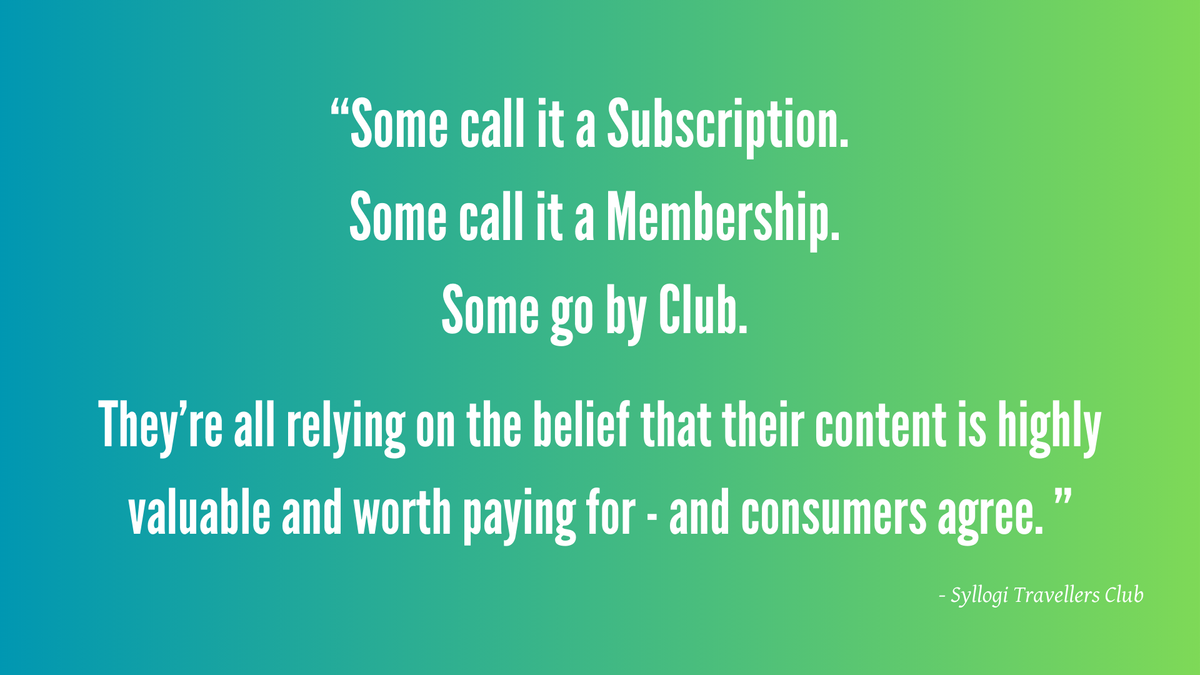Tastemakers and the Rise of Members-Only: Part 2
Authentic taste - a future luxury for those overwhelmed by internet search

By Erin Washington and Gray Shealy
Taste...just a different sort.
In our initial discussion on taste back in Edition Five, we suggested that good, quality information is increasingly difficult to find, especially given algorithmic bias that prioritizes paid sponsorships over meaningful results. Moreover, we suggested that tastemaking - whereby a creative with a distinct point of view - is the last bastion of quality information and such viewpoints will become a future luxury, worthy of investment. In this second act, we discuss how the rise of memberships are playing financial and physical host to such curators who strive for authenticity amongst genuine audiences of their own creation.
PART TWO: TASTEMAKERS LIVE IN THE CLUBS
Where Tastemakers ultimately “live” on the internet is a relatively new phenomena. Gone are the days when a tastemaker’s independent website could be discovered by organic Google search (e.g. not paying their way to the top). “Creators and audiences alike are feeling fatigued after a decade of visual content ruling online, and negative sentiment towards short-form trend-led content is rising,” declares Sasha Mills, a digital culture specialist. “Creators have to work harder to stand out on platforms that offer increasingly dwindling returns.” As such, independent content platforms like Substack, Medium, and Ghost have become host to a fleet of tastemakers, and gives them a place to express more substantive content, diversify their income, and nurture supportive, long-lasting audiences that value their intel. These platforms generally shun the headaches and impossible struggles of SEO and sponsorship in lieu of organic discovery.
THE CONSUMPTION BELL CURVE AND THE MEMBERS-ONLY INTERNET
Over the last year, there has been an increasing number of media outlets and content creators adding a paywall to their content. Some call it a subscription, some call it a membership, some go by club. They’re all relying on the belief that their content is highly valuable and worth paying for - and consumers agree.
In most cases, this move to paid content isn’t a result of greed, it’s a survival tactic required in the new era of algorithms and AI. There’s too much information out there, and with an incoming influx of AI-generated material, the volume of information on the internet is only going to multiply. The decrease in “eyes” on their content is resulting in less ad dollars, a core financial model for most media outlets. Relying on ad-based revenue is no longer financially viable. Moreover, there is a moral and ethical factor for many tastemakers who have to weigh the quality and authenticity of their content against the sponsorship dollar. Enter: the paywall.
Memberships offer a strategic approach to reach the customer in new and interesting ways. They are centered on niche content of various formats, communities, and experiences that align with the taste of the consumer. This is where these new platforms have thrived: allowing the Tastemaker to assume ownership over their knowledge, remain credibly authentic, and connect with their readers.
From the consumer's perspective, such membership clubs and paid-for subscriptions will become more attractive for those who are struggling to find quality information, and don’t have time to do the digging themselves. As noted in a recent edition of Vogue, “where search engines and social media apps are increasingly algorithmically cleansed to the effect of a monotonous trend-driven sameness, Substack accounts have thriving communities providing inspiration and advice from both creators and their audiences, who are willing to pay a monthly fee for better recommendations, access to a like-minded community and a unique POV.” In such niche followings, the membership model is a new premium resource for those in-the-know, standing at the end of an information consumption bell curve, where common (free) content is distinct from highly coveted and unique intel.
The value of digital spaces that prioritize the authentic expression of content and intel, free from the confines of AI and algorithmic games will only continue to grow. It is up to discerning and knowledgeable audiences to find and support the tastemakers with whom they resonate in order to make wise decisions for themselves and their lifestyles. In this way, the art of tastemaking is the future of human-apropos, quality information: a luxury limited to those who choose to opt for the membership, opening doors to a refreshing new library of exceptional and thoughtful intelligence.
___________
References:
Azout, Sari. “Everyone’s Talking About Taste.” The Sublime. 22 June 2024. https://sublimeinternet.substack.com/p/everyones-talking-about-taste
Hatinoglu, Besim, et al. “The Society of the Illusionists.” Gastromondiale. 3 March 2024. https://www.gastromondiale.com/2017-6-27-the-society-of-the-illusionists-the-worlds-50-best-restaurants-list/
Mayorga, Katalina, CEO. El Camino Travel. LinkedIn, April 2024. https://www.linkedin.com/in/katalinamayorga
Murrell, Alex. “The Age of Average.” 20 March 2024. https://www.alexmurrell.co.uk/articles/the-age-of-average
Sietsema, Tom. “Why I’m saying goodbye to star ratings in my restaurant reviews.” The Washington Post. 22 October 2022. https://www.washingtonpost.com/magazine/2022/10/03/restaurant-reviews-star-ratings/
Truman, Isabelle. “To Escape the Algorithm, Fashion Girls are Shopping via Substack.” Vogue Business. 26 March 2024. https://www.voguebusiness.com/story/consumers/to-escape-the-algorithm-fashion-girls-are-shopping-via-substack
Photo Source: Syllogi
Syllogi aspires to help you travel better. Our occasional long-form essays think deeper about the importance of travel and what it means for our collective future.




